Functionality vs Aesthetics
Finding harmony in workspaces
Gentle Reader,
My mind has often alighted on the topic of the perfect desk setup. After all, how should one write?
Marcel Proust used to write from bed, using pen and ink to annotate fresh paragraphs into the margins of his manuscripts. Jack Kerouac harnessed the power of a wave of manic energy whilst writing On The Road by scribbling it all down on a single continuous scroll of paper which was 120 feet long. Nabokov used index cards which he eventually compiled into a full novel, and Maya Angelou famously used to rent hotel rooms to create a sensation of space and freedom.
There are many ways to work. For example, which of the below setups looks more ‘optimal’ to you?
vs
It is perhaps a little bit of an unfair comparison, given that one of the setups has a sea view, but the obvious answer is that it depends on what you intend to do, and it probably also depends on what you require physically and ergonomically and…spiritually.
Right now for example, I am lying in bed, propped up by pillows, with an over-bed desk positioned across me. The desk did not initially fit under my bed and so I had to buy blocks to raise my bed, adding another step to the eternal pursuit of perfection. This position will be comfortable for maybe 1-2 hours, before I will want a change – flexibility is important, to be able to work from different positions, in accordance with what our body calls for.
Yet, in the eternal search for a ‘perfect’ desk setup, the latest approach to catch my eye came from a note by
.I loved the simplicity of his approach, a keyboard and an e-ink device called a Daylight…but am I just fooling myself again that I need another device? Probably.
What appealed to me about this setup is that, recently when on a plane flying home, I typed quite a lot on my iPad and found it to be a good experience.
This was counter-intuitive as I thought that everything about it would be sub-optimal: the screen too small, the keyboard too small, the position of screen and keyboard, linked as they were, potentially a cause of back pain, and of course the general jankiness of the keyboard.
Yet it felt nice. I decided to ask ChatGPT why – here’s an abbreviated version of what it gave me:
1. Simplicity and Focus
Fewer distractions: iPads tend to run one app at a time in full-screen or split-screen mode, so your workspace feels cleaner. No tabs, popups, background apps buzzing.
Minimalist interface: Many iPad writing apps (like iA Writer or Apple Notes) are designed to be stripped-down and calm.
2. Posture and Environment
More casual posture: You're likely lounging or sitting comfortably when using an iPad, rather than sitting at a desk like you would with a laptop.
Different setting: You might take your iPad to a couch, bed, or a sunny corner—so the whole context feels more relaxed.
3. Tactile and Cognitive Shift
Touch-based interaction: Even if you’re typing with a keyboard, you're still tapping and swiping sometimes, which can feel more direct and intuitive.
"Not work" association (no pressure to be “productive”): Many people associate laptops with work, pressure, or deadlines. iPads are often associated with reading, browsing, or drawing—so the act of typing may feel more playful or less pressured.
I think GPT is onto a winner here. The inability to easily swipe across to another tab, combined with its usability sitting or lying down, and the casual nature of the device definitely seem to help.
Is there a way to simulate even more organically? Perhaps Nat has done so with his Daylight device, but the present writer has bought enough gadgets to last a lifetime, so I won’t be going there just yet.
In the meantime, I’ll stick to optimising my desk setup. I have a bookmark saved for years of a video from Ali Abdaal entitled ‘My Most Productive Desk Setup Ever’, which I refer to occasionally to let myself dream of endless productivity, without having any real intention of buying the items in the video.
Ali’s setup is the best of the best, with the most up-to-date and highest spec devices, but I would be curious to know if Ali’s desk setup really meaningfully improves his productivity. I say that not with scepticism but of genuine curiosity.
I think there is a good chance that it does, but I think that he and I are wired differently and that some people respond more to functionality in order to work, whereas others respond more to aesthetics.
In the video, Ali himself says “I’m not trying to optimise for aesthetics here, I’m trying to optimise for functionality” which is a great insight. A writer of fiction or a newsletter is going to have different demands compared to somebody like Ali who juggles videography, coding, meetings, writing, etc.
Functionality vs aesthetics
The tension between functionality and aesthetics is a time-honoured clash of two titans. Think of that spare room you see in many houses – going by cliché, if the wife gets her hands on it, it might end up being a charming little spare bedroom, or if the husband gets his grubby hands on it, it may well end up as a mixed-use space, with both a home-office and home-gym setup.
At a certain level, the craving for an aesthetic is that it sometimes, deep down, suggests an elite kind of functionality. The simple desk in the image at the start of this article evokes a kind of functionality in a time before social media and widespread computer usage, a time when, allegedly, you had no choice but to write. But this comes from a yearning, a dangerous kind of poison of the mind which one must be wary of.
Yet it rings true that such a space could be the most functional space possible for the right person. It could be both aesthetic and functional, if it were beautiful and beautifully in harmony with the life of the writer, and in harmony with his or her objectives in life in a way which facilitates the work of the true self.
The Hardware
Yet, the software developer or the analyst must bow, ultimately, to functionality alone. He or she will have to go all-in on standing desks, on under-desk treadmills, on multiple monitors. Context being king, such setups always look better in an office rather than at home.
I technically own a standing desk and a little treadmill, although neither reach the dizzying heights of what we see in Ali’s video. The standing desk is not electronic, which means I have to haul it up and down, with a grunt, by the hinges. It was actually designed for people who cycle at home to leave their iPad or laptop, which simulates their virtual race, on top of it. The treadmill is not quite so fancy as Ali’s either. I tried it out but it didn’t really work that well for me, I really just couldn’t concentrate while walking slowly. Probably it would have been fine in meetings, albeit possibly regarded as a bit odd by co-workers, and it probably would have been fine for somewhat dull non-creative work, which I don’t currently do a lot of. Either that or I’m just too dumb to walk and think and operate at the same time, as I remember it was a little difficult to write while using it.
And so, even if the health benefits are obvious, it was a no for me. Plus, there were additional drawbacks, most notably the vibe shift borne of having a treadmill by your bedroom desk and also the space occupied by such a device.
It’s hard to not feel like a bit of a wuss for relying on technology to accomplish basic feats like writing – imagine Ernest Hemingway walking on a treadmill desk with dual monitors, airPods in his ears and both mouse and trackpad at his disposal.
Ali himself addresses this later in his video, mentioning that it is great to have two desk setups for different ‘modes’ of working. He seems to have relegated the walking treadmill to his secondary desk, where he takes meetings, plays games and also writes.
Harmony with the work
Let’s return to the topic of the type of work which we are doing. One setting which might be optimal for productivity may not be optimal for creativity. Creative work requires, to my mind, a vacuum of sorts, and the overly-optimised productive environment perhaps fills too many gaps, creates too many certainties for this kind of mindset. But of course, people are different and what stimulates one person’s creative impulse might be anathema to another’s.
One gets the feeling, however, that the desk should be in harmony with its output and with its environs. If you cannot have two workspaces (unlike Ali), and if you are a sensitive type like me, your chosen space must be an extension of its environment and, to some extent, an extension of yourself. If you live in an old cottage by the sea, it will most likely look odd if you have a desk with three monitors and an ergonomic chair and a folding treadmill.
All of the above, of course, goes without saying that desks aren’t the only way to work, at least not in their traditional sense. As I said before, it’s more about finding a mode which works for you.
Right now, this over-bed desk works for me. Lying down in bed worked for Marcel Proust, although I’m not really sure what he did about neck and back pain, but having said that he probably didn’t spend his non-working hours looking at a smartphone.
In the end, it does perhaps seem a little silly to discuss the minutiae of work environments, when for all of modern history some great works which may never be surpassed were produced with a simple pen, paper, worm-eaten desk, and a crick in the neck. All of this without mentioning that Shakespeare produced his entire canon without drinking a single cup of coffee – one can only conclude that he must have been ‘locked in.’ Of course, he was also not distracted by notifications, thirst traps, or antibiotics, or drinkable tap water.
For my part, maybe one day I will buy that big fancy desk when I have some real estate to put it in.
Until then I will keep tinkering and daydreaming, and maybe I’ll even buy that fancy device of Nat’s. But for the present, the good old Macbook will suffice, occasionally interspersed with periods on the iPad, all of which is much more than the greats ever had access to, and should be good enough for me.
Thanks for reading! Subscribe below to get my posts sent straight to your inbox.
Affiliates:
My friend Paul Millerd runs the Pathless Path Community, a cozy online space where we support each other to find ways to live and work in the most authentic way possible.
I also recommend the Supernote e-ink device, which I use for reading, writing, and annotating documents. This affiliate link is only valid for EU customers.



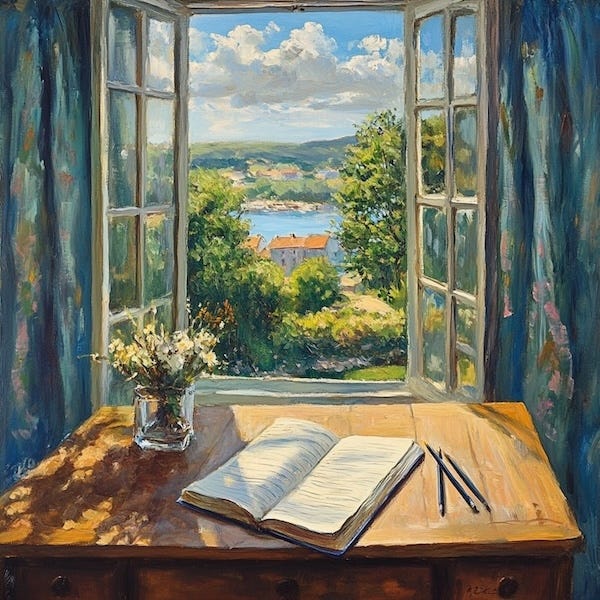
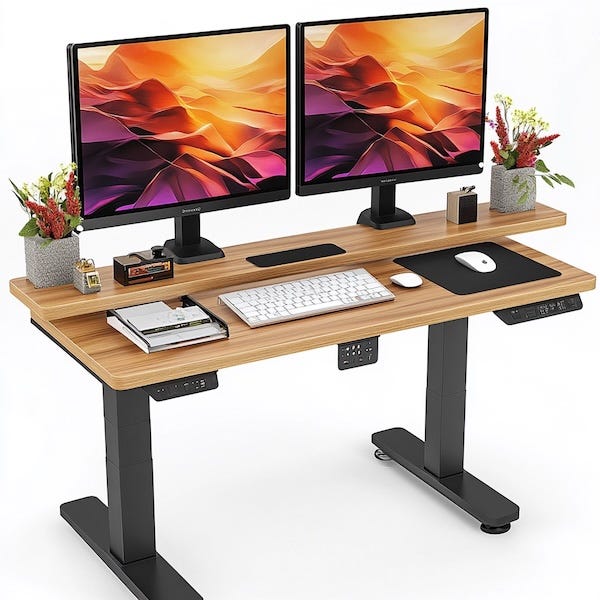
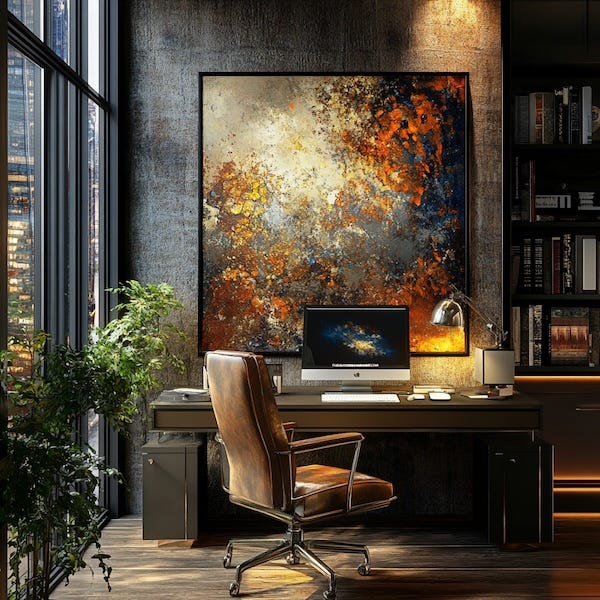
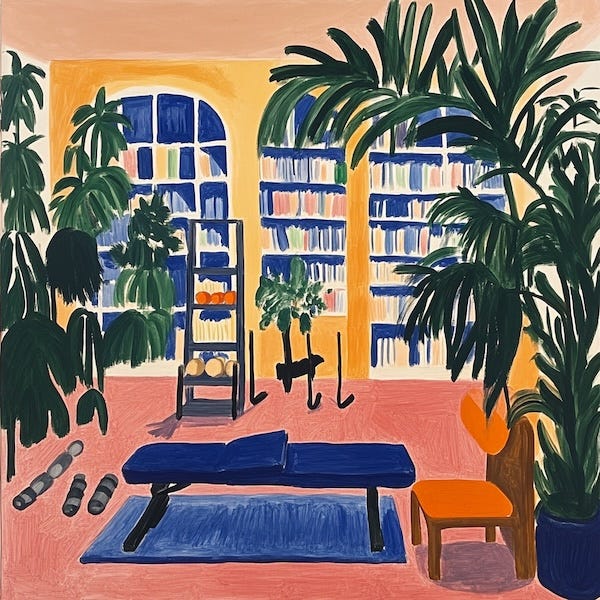
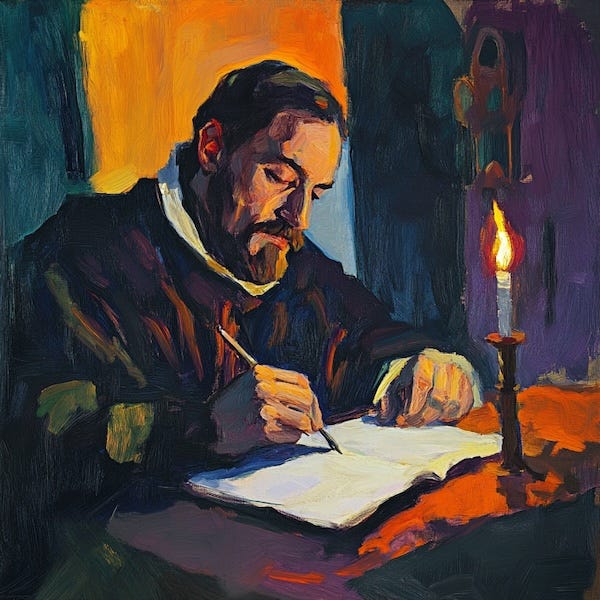
I love my office, it’s my favorite room in the house. I never thought whether it’s functional OR aesthetics, but more that it makes me feel good every time I walk in.
For me, the necessary requirements:
- sunlight
- look up and easily see out a window
- empty desk (only Mac)
- surrounded by books that inspire me (get rid of “meh” ones)
- a door to keep everyone else out 😂
I recall seeing a picture of the great novelist Graham Greene writing at a tiny secretary desk that appeared to only have enough space for a notebook. He supposedly would only write a page a day, but he did it every day.
Of course, I am writing this from my big Mac, but at least the desk faces the street and I can peer around the corner of the computer for passersby of all sorts. It's pretty good.